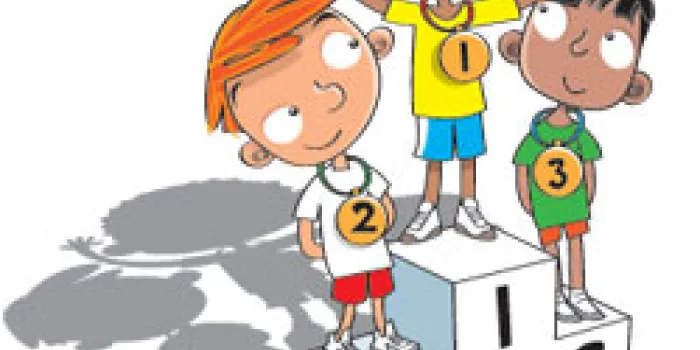Are you ready? The 2008 Summer Olympic Games begin in August in Beijing, China. Did you know the Games have been going on for thousands of years? They began in 776 BC in ancient Greece—that’s nearly 3,000 years ago! Today, both the summer and winter Games are held every four years, in places all over the world like France, England, Japan and Australia. Athletes compete in 28 Summer Olympic sports, like swimming, gymnastics and rowing.
Becoming an Olympic athlete takes a lot of hard work and practice. You have to train for many years to make sure you have enough energy and a strong body. The good news is that you don’t have to be an Olympic athlete to enjoy Olympic sports. Here are a few you can try:
Archery
Have you heard the legend of Robin Hood? He is probably the most well-known archer in storybooks. The sport of archery is simply shooting a bow and arrow. You can learn at camp, or your school might offer archery teams. To do it, you’ll need strong shoulder muscles, steady hands and a clear eye. Pull back on the bow and send your arrow shooting into the round target. The center ring of the target, or bullseye, earns you the most points. The farther from the target you hit, the fewer points you get. As with any sport, it can be unsafe sometimes, so let your parents or teachers help you, and don’t forget to wear long arm guards to protect yourself!
Swimming
Swimming is a great activity and a big part of the Olympic Games. It also can be a good sport for kids with bleeding disorders. That’s because it can build up your bones and strengthen your muscles without hurting your body. Your body floats in water, which takes pressure off your joints. Also, water pressure from being underwater can help manage swelling. Swimming has four main strokes: freestyle, backstroke, breaststroke and butterfly. Freestyle and backstroke are good places to start. Then, once your muscles are stronger, you can move onto the tougher breaststroke. If you want to start swimming, be sure to sign up for lessons with a certified teacher, such as at the American Red Cross or YMCA. Also, be sure to tell your swim coach about your bleeding disorder and what joints might need extra care.
Rowing
Rowing is an Olympic sport. Up to eight rowers in one boat sprint down rivers and lakes at about 40 strokes a minute. That’s fast! Rowing is a great workout and helps tone your upper body. But you don’t need to go as fast as the Olympic athletes to have fun and be healthy. Instead, you can use a rowing machine to strengthen your arms, back, shoulder and stomach muscles. Just be sure to ask a physical therapist or someone older to show you the proper body position to avoid injury.
Cycling
When bicycles were invented, they had a big wheel in the front and a small wheel in the back. This made them very dangerous to ride. Today, bikes are sleek and fast, and cycling is a popular Olympic sport. Olympic cycling has four types: road, around a track, on a mountain path or BMX (which is not recommended for people with bleeding disorders). Riding a bike is fun and can be a great sport for kids with bleeding disorders. Just remember to wear a helmet, ride on the sidewalk or paved path and stay away from any cars.
Table Tennis
Have you ever seen a game of tennis? This sport is a lot like tennis, except you play it on a hard table divided by a net, not on a court. Some people call it “ping-pong.” Two or four players hit a lightweight ball back and forth to each other using paddles. In an Olympic ping-pong match, play is very fast. Sometimes, the ball can go as fast as 70 miles per hour! Playing at home with friends can be a lot of fun, too. If you have paddles and a ball, any table can be turned into a perfect spot for a ping-pong match.
As with all sports, don’t forget to stretch your muscles and warm up! And if you have questions, ask your parents, doctor or hemophilia treatment center about the best way to play these sports and stay healthy. To learn more about sports that are right for you, read the NHF booklet “Playing It Safe: Bleeding Disorders, Sports & Exercise.”

